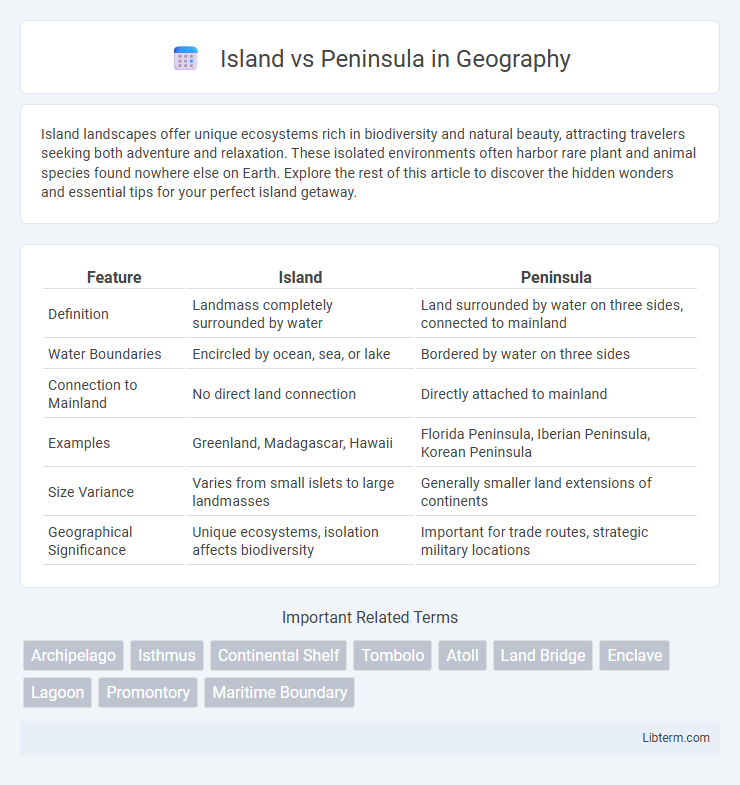Island landscapes offer unique ecosystems rich in biodiversity and natural beauty, attracting travelers seeking both adventure and relaxation. These isolated environments often harbor rare plant and animal species found nowhere else on Earth. Explore the rest of this article to discover the hidden wonders and essential tips for your perfect island getaway.
Table of Comparison
| Feature | Island | Peninsula |
|---|---|---|
| Definition | Landmass completely surrounded by water | Land surrounded by water on three sides, connected to mainland |
| Water Boundaries | Encircled by ocean, sea, or lake | Bordered by water on three sides |
| Connection to Mainland | No direct land connection | Directly attached to mainland |
| Examples | Greenland, Madagascar, Hawaii | Florida Peninsula, Iberian Peninsula, Korean Peninsula |
| Size Variance | Varies from small islets to large landmasses | Generally smaller land extensions of continents |
| Geographical Significance | Unique ecosystems, isolation affects biodiversity | Important for trade routes, strategic military locations |
Definition of Island and Peninsula
An island is a landmass completely surrounded by water, isolated from other land areas. A peninsula is a piece of land bordered by water on three sides but connected to the mainland on one side. Islands vary in size from small islets to large landforms like Greenland, while peninsulas range from narrow strips of land to extensive landforms like the Iberian Peninsula.
Geographic Differences
An island is a landmass completely surrounded by water, whereas a peninsula is a piece of land almost entirely surrounded by water but connected to a mainland via an isthmus. Islands can vary in size from small atolls to large landforms like Greenland, while peninsulas often extend into bodies of water such as seas or oceans, exemplified by the Florida Peninsula. The geographic distinction lies in the presence of a continuous land connection for peninsulas, contrasting with islands' complete isolation by water.
Formation and Geological Origins
Islands form through volcanic activity, tectonic movements, or sediment accumulation in bodies of water, often arising from underwater eruptions or coral growth. Peninsulas develop from landmasses extending into water due to tectonic uplift, erosion, or sediment deposition shaping coastal contours. Geological origins of islands and peninsulas reveal distinct processes: islands are isolated by water, while peninsulas connect to a mainland, reflecting differences in plate tectonics and sediment dynamics.
Examples of Famous Islands
Famous islands such as Hawaii, Madagascar, and the Galapagos are notable for being completely surrounded by water, distinguishing them from peninsulas like Florida or the Iberian Peninsula, which are connected to larger landmasses. Islands offer unique ecosystems and biodiversity due to their isolation, exemplified by Madagascar's endemic species or the Galapagos' role in evolutionary studies. Understanding these distinctions highlights the geographic and ecological significance of islands compared to peninsulas.
Examples of Famous Peninsulas
The Italian Peninsula, also known as the Apennine Peninsula, is famous for its distinct boot shape and houses major cities like Rome and Naples. The Iberian Peninsula includes Spain and Portugal, serving as a significant cultural and historical region in southwestern Europe. The Arabian Peninsula, the largest peninsula in the world, is known for its vast deserts and oil-rich countries such as Saudi Arabia and the United Arab Emirates.
Biodiversity and Ecosystems
Islands often host unique biodiversity due to their isolation, fostering high rates of endemism and specialized ecosystems distinct from mainland areas. Peninsulas share more ecological connectivity with continental habitats, supporting a mix of terrestrial and marine species with wider genetic flow. The ecological dynamics of islands promote evolutionary divergence, while peninsulas serve as biological corridors enhancing species migration and ecosystem resilience.
Human Settlement and Culture
Islands often develop unique cultures and isolated human settlements due to limited land connections, fostering distinct traditions and languages shaped by geographic isolation. Peninsulas facilitate more extensive human settlement and cultural exchange because of their connection to larger landmasses, allowing easier trade, migration, and interaction with neighboring regions. The accessibility of peninsulas enables diverse cultural influences and economic integration, contrasting with the often insular development of island communities.
Economic Activities and Industries
Islands often rely heavily on tourism, fishing, and maritime trade due to their geographic isolation and access to surrounding waters, fostering industries such as hospitality, aquaculture, and shipping. Peninsulas benefit from easier land connectivity, supporting diverse economic activities including agriculture, manufacturing, and transportation industries, often acting as trade hubs between mainland and coastal regions. Both landforms leverage natural resources and strategic locations, but the scale and variety of industries differ, with islands focusing more on marine-based economies and peninsulas accommodating broader industrial development.
Tourism and Attractions
Islands offer unique tourism experiences with pristine beaches, marine biodiversity, and secluded resorts attracting visitors seeking relaxation and water activities. Peninsulas provide diverse landscapes combining coastal charm with accessible mainland attractions, such as cultural sites, hiking trails, and vibrant local communities. Popular island destinations like Maui and Bora Bora draw beach lovers, while peninsulas like the Florida Keys and the Yucatan Peninsula offer a blend of nature, history, and adventure tourism.
Environmental Challenges and Conservation
Islands face unique environmental challenges such as limited freshwater resources, habitat fragmentation, and vulnerability to sea-level rise due to their isolation and finite land area. Peninsulas encounter ecosystem pressures from both marine and terrestrial sources, including coastal erosion and human development impacting biodiversity corridors. Conservation efforts on islands often emphasize protecting endemic species and replenishing freshwater supplies, while peninsula strategies focus on managing coastal habitats and mitigating pollution from urban expansion.
Island Infographic

 libterm.com
libterm.com